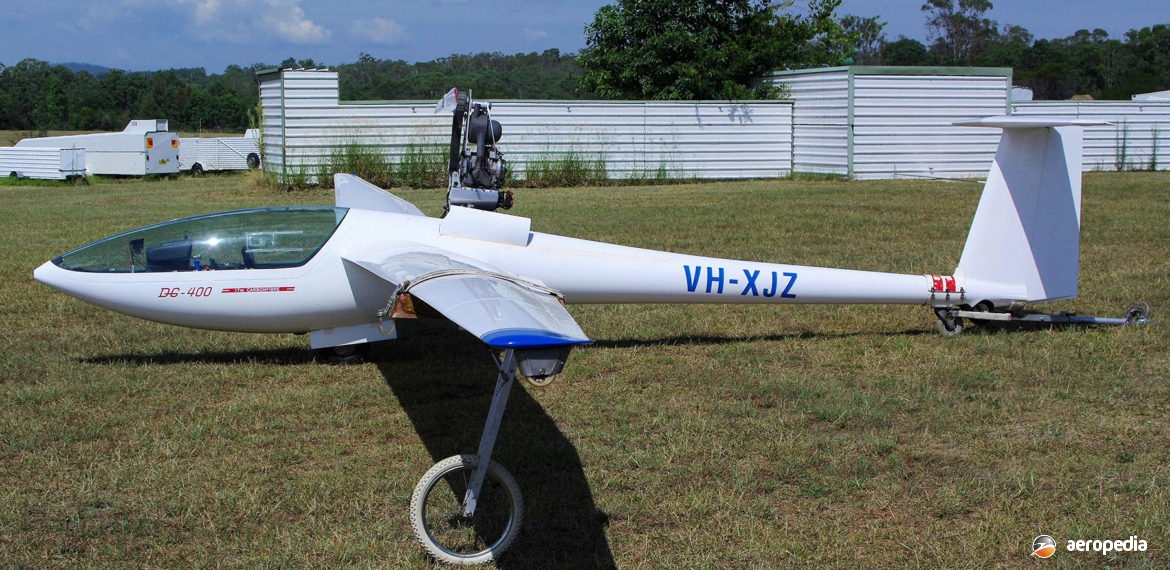Photograph:
Glaser-Dirks DG-400 VH-XJZ (c/n 4-275) at Camden, NSW in February 2011 (David C Eyre)
Country of origin:
Germany
Description:
Self-launched glider
Power Plant:
(DG-400)
One 32 kw (43 hp) Rotax 505 two-cylinder horizontally-opposed air-cooled engine
Specifications:
(DG-400)
- Wingspan: 17 m (55 ft 9 in)
- Length: 7 m (23 ft)
- Height: 1.4 m (4 ft 7 in)
- Wing area: 10.57 m² (113.8 sq ft)
- Never exceed speed in smooth air: 270 km/h (168 mph)
- Economical cruising speed: 130 km/h (81 mph)
- Max cruising speed: 140 km/h (87 mph)
- Range in level flight: 400 km (249 miles)
- Range on cruise and soar: 750 km (470 miles)
- Service ceiling: 5,000 m (16,404 ft)
- G limits: +6/-4
- Max glide ratio: 47 at 110 km/h (68 mph)
- Rate of climb at 80 km/h (50 mph): 234 m/min (768 ft/min)
- Rate of sink: 30 m/min (98 ft/min)
- Wing loading: 43.5 kg/m² (89 lb/sq ft)
- Stalling speed: 64 km/h (39 mph)
- Take-off run: 200 m (656 ft)
- Empty weight: 310 kg (683 lb)
- Payload: 155 kg (342 lb)
- Loaded weight: 460 kg (1,014 lb)
History:
Glaser-Dirks Flugzeugbau was formed by Wilhelm Dirks and Gerhard Glaser at Alkafleg Darmstadt to develop and build gliders in Germany for the world market. The first design was the D-38, which first flew in February 1973. It was followed in May 1974 by the DG-100 and DG-200, and since then the Company has continuously produced a range of gliders / sailplanes to meet a variety of demands. Amongst these has been the DG-300, DG-400 and DG-500 series of self-launched sailplanes, a variant of the latter being known as the DG-505 Elan Orion with a 20 m (65 ft 6 in) wing.
The DG-400 was a single-seat high-performance glider which was self-launched, most of the powered variants of the series having a 32 kw (43 hp) Rotax 505 engine behind the pilot driving a 1.29 m (4 ft 3 in) two-blade Hoffman propeller. The first of this variant flew in 1981, and was basically a Model DG-202 with an engine. It had a 15 m (49 ft 2 in) wing with add on wing tips which increased wingspan to 17 m (55 ft 8 in), and an electric extraction system which deployed the dual-ignition two-cycle engine.
More than 250 examples have been delivered around the world. A DG-400 in Switzerland set a world 500 km (310.69 miles) speed record at 170.66 km/h (105.7 mph). The DG-400 was later developed into the DG-500 and DG-600 series, also self-launched models, the latter having a gross weight of 525 kg (1,157 lb).
Further variants produced have included the DG-600 and DG-800, the latter having an 18 m (59 ft) wing with an area of 11.81 m² (127 sq ft) and a gross weight of 525 kg (1,157 lb). It could be fitted with a variety of engines, including the 37 kw (51 hp) MidWest AE 50 and 40 kw (55 hp) Oehler Solo 2625. The first DG-800 flew in 1991 and was developed through the un-powered DG-800S, the Rotax powered DG-800A and the liquid-cooled buried engine configuration of the DG-800B. It could be fitted with either the 15 m (49 ft 2 in) or 18 m (59 ft 1 in) wing.
This series has been popular in this region and examples of most models have been registered over the years with the Australian and New Zealand Gliding Federations. A DG-800B registered in New Zealand was ZK-GEM (c/n 8-241B155) built in 2001.

